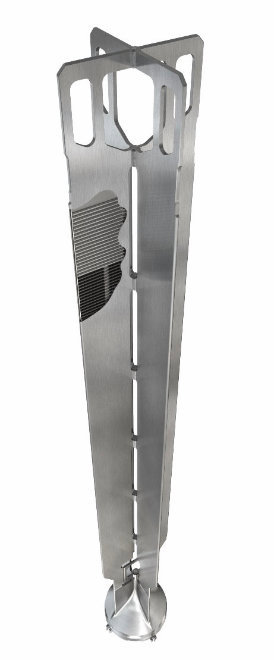
Westinghouse CR 99+ control rod design
Background
The boiling water reactor (BWR) control rod of today must meet high operational demands while at the same time contribute to decreased operational costs for the plant operator.
Description
The Westinghouse BWR control rod design consists of four stainless steel sheets welded together to form a cruciform-shaped rod. Due to this configuration, the product is also known as control rod blade (CRB). Each sheet has horizontally drilled holes to contain absorber material, boron carbide (B4C) and hafnium. These horizontal holes, allow significantly more B4C in the rod, offering a longer service life versus traditional CRBs in most reactors.
CR 99+™ Design
The CR 99+ control blade, a hafnium tip design, has mainly hot isostatic pressed B4C pins as absorber material. A gap is designed between the pins and the walls of the drilled holes such that the B4C, which swells due to neutron capture, does not interact with the structural material to create detrimental stresses leading to stress corrosion cracking. In the tip of the CR 99+, hafnium is used as the absorber material. Hafnium has a slower depletion rate than B4C, which is beneficial regarding the ex-core flux to the tip of a withdrawn CRB. Furthermore, hafnium does not swell as a result of neutron irradiation. The hafnium tip is a proven feature in Westinghouse CRBs for 40 years.
Benefits
- High-duty control rod with hot isostatic pressed (HIP) B4C pins as absorber material
- Hafnium tip with low depletion rate, when operated fully withdrawn
- Extended service lifetime
- Reactivity worth equal to or higher than the original control rods
- Structural material with high resistance to stress corrosion cracking (SCC)
- Low-cobalt content to minimize activation
- Horizontally drilled absorber holes proven to retain B4C
- Easy waste disposal
Experience
Westinghouse began developing BWR control rod designs in the mid-1960s. The first control rod, an all-B4C rod called CR 70, started operation in 1970. Many original rods have been operated well above 40 years, with full integrity maintained, proving the robustness of the Westinghouse BWR control rod design.
Westinghouse developed the hafnium tip in the 1980s after recognizing that CR 70 control rods, even when fully withdrawn from the core, still were exposed to neutron fluence at the tip. Hafnium does not swell significantly due to neutron capture. The introduction of the CR 99 provided an alternative to the use of hafnium, leveraging B4C pins with carefully engineered gaps and tolerances. The CR 99+ design was introduced in Scandinavian BWRs in 2013. It combines the engineered gaps for the B4C pins with the low depletion rate of hafnium at the tip. That development was driven using enriched material for the fuel bottom nodes in European reactors.
Westinghouse has delivered more than 7,000 BWR control rods. Almost 250 CR 99+ have been delivered to European BWRs.
Westinghouse BWR control rods are licensed in the United States, Germany, Spain, Switzerland, Sweden, Finland and Taiwan.
CR 70, CR 99, and CR 99+ are trademarks or registered trademarks of Westinghouse Electric Company LLC, its affiliates and/or its subsidiaries in the United States of America and may be registered in other countries throughout the world. All rights reserved. Unauthorized use is strictly prohibited. Other names may be trademarks of their respective owners.


